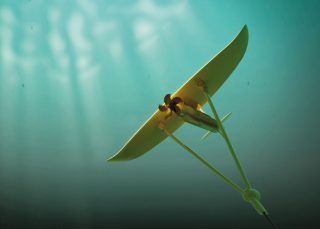
Background
Swedish start-up Minesto is developing an innovative Deep Green tidal power plant, off Holyhead in northern Scotland, which is expected to allow the installation of cost-effective tidal systems in slow marine current areas in the future.
Characteristics
Swedish start-up company Minesto has developed a Deep Green tidal power project off the coast of Holyhead, North Wales. This project follows tests already completed on a firts demonstrator in Northern Ireland.
The commercial demonstrator has the following characteristics:
- A mobile wing about 12 meters long and 3.3 m wide, performing a trajectory in 8 provided by two rudders controlled by an automated control system
- the wing is made of composite materials and has a total weight of 3 tons
- a 500 kw turbine of 7 t
- a rotor of 1.15 m in diameter
- fixation possible from 90 to 120 m in depth
- 110 to 140 m long cable of 11 tons : this attachment cable also serves as a guide to the electric cable and to to the cable transmitting the controls to the steering system
- a concrete foundation with the following dimension : 21.5 meters x 12.75 meters x 4.7 meters
- the device is suitable for marine or tidal currents from 1.5 to 2 m / s
- 16 tidal turbines can be settled in 1 square kilometer
The project is supported by European funds up to 13 million for a total cost of 30 million for the installation of three machines.
The initial objective was to eventually install 20 machines over 1 km square, for a production of 10 MW covering the electricity needs of 8000 households. The initial objective was extended to 80 MW.
Innovation
The Deep Green tidal turbine is based on knowledge in hydrodynamics and aeronautics.
Indeed, the innovation lies in the design of a submarine wing performing movement in 8.
The movement of the wing then creates a mutiplied apparent water movement activating the blades of the integrated turbine.
This system makes it possible to use and make profitable the Deep Green device in water currents lower than 2.5 m / s and at significant depths of the order of a hundred meters.
Therefore, this new technology offers new possibilities compared to conventional tidal turbines that are only profitable from a current speed higher than 2.5 m / s and can only be installed at lower funds. depths of 30 to 50 m. .
In addition, the system has been designed to allow surface maintenance operations without specific vessels to reduce the cost of operation and maintenance.
Timeline
June 2014
The Crown Estate leases a 10 megawatt facility to Holyhead Deep.
September 2015
Minesto operates a capital opening to complete the financing of the commercialization phase.
December 2015
Minesto and its partners receive funding from the European Horizon 2020 program to develop Deep Green technology with the PowerKite project.
February 2017
Minesto reveals its commercial deployment plan, with the goal of an installed capacity of 80 MW. The increase in installed capacity will reduce the LCOE by 50% compared to a demonstration farm of 10 MW.
This deployment must be done in two steps: installation of the 500 kW demonstrator (DG 500), then development of a larger commercial network.
March 2017
Green Marine of Southampton wins the tender for the manufacture of the composite elements of Deep Green. The Dutch company FibreMAx will produce the Dyneema high-tech fiber rope lanyard.
April 2017
Minesto obtains from Natural Resources Wales the marine license to install and operate Deep Green.
During this process, an environmental impact study was conducted, noting that the impacts of Deep Green on the marine environment were not significant.
October 2017
The energy cost projections advanced by Minesto are considered significant by Marine Energy Wales.
These projections predict that the Deep Green LCOE will fall to 100 euros / MWh, or even 50 euros MWh for a DC ocean installation, with a cumulative installed capacity of 100 MW.
The energy produced would then become more profitable than nuclear power.
February 2018
The finished concrete foundation is ready for delivery.
June 2018
Minesto is selected by the ” Horizon 2020 SME Instrument” program to carry out a commercial reliability study of a smaller 100 kw variant of Deep Green: DG 100. This new device will be used in “Island” or “off-grid” modes “.
July 2018
Installation of the “kite” and start of commissioning in two phases: tests of functionality followed by tests of production of electricity.
September 2018
The first phase of commissioning, namely the functional verification phase, is completed.
October 2018
Minesto starts to produce electricity.
Photo credit: MINESTO

